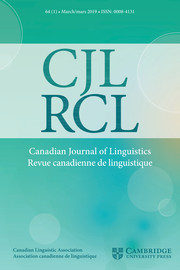Harbour (2016) argues for a parsimonious universal set of features for grammatical person distinctions, and suggests (ch. 7) that the same features may also form the basis for systems of deixis. We apply this proposal to an analysis of Heiltsuk, a Wakashan language with a particularly rich set of person-based deictic contrasts (Rath 1981). Heiltsuk demonstratives and third-person pronominal enclitics distinguish proximal-to-speaker, proximal-to-addressee, and distal (in addition to an orthogonal visibility contrast). There are no forms marking proximity to third persons (e.g., ‘near them’) or identifying the location of discourse participants (e.g., ‘you near me’ vs. ‘you over there’), nor does the deictic system make use of the clusivity contrast that appears in the pronoun paradigm (e.g., ‘this near you and me’ vs. ‘this near me and others’). We account for the pattern by implementing Harbour's spatial element χ as a function that yields proximity to its first- or second-person argument.
Publication Type
- Article



